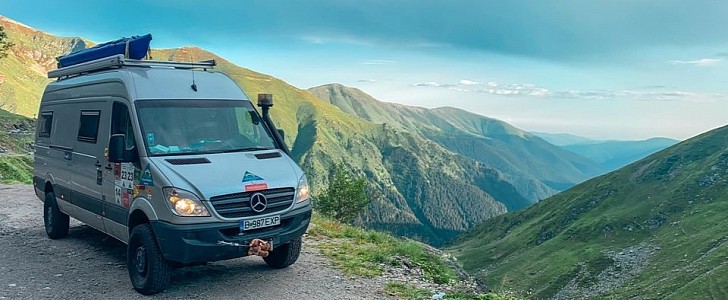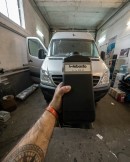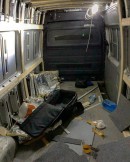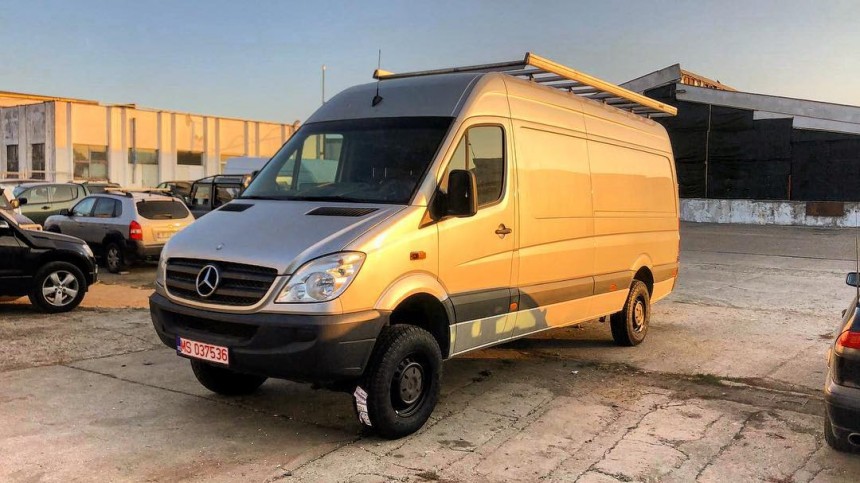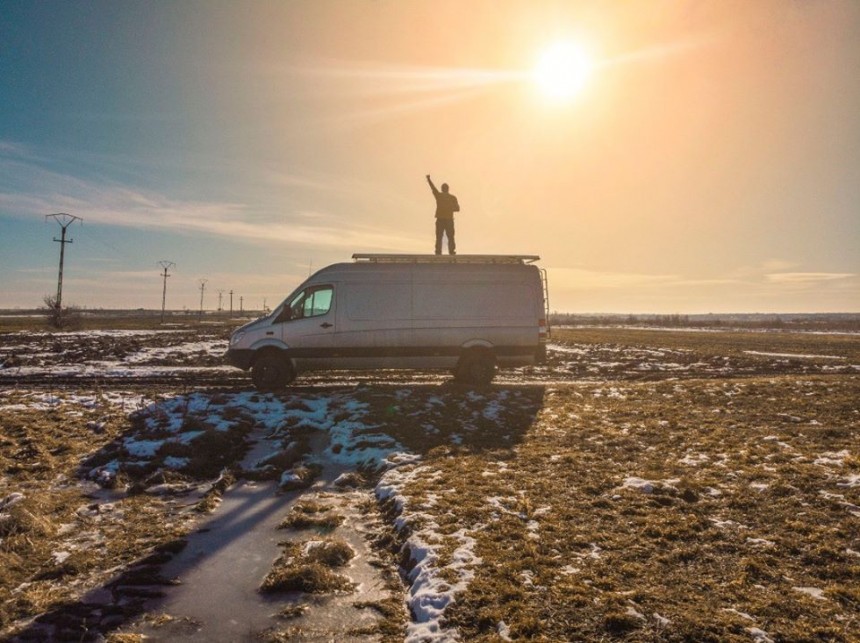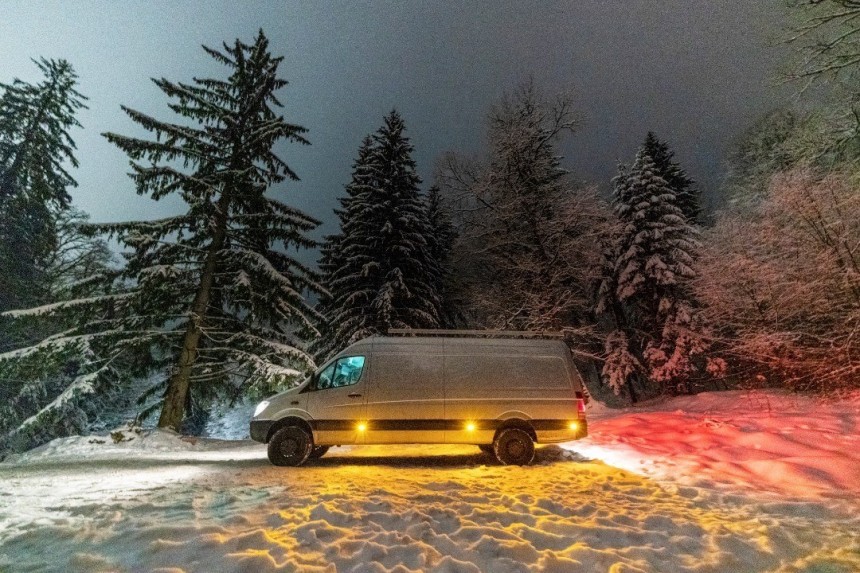Buying an Earth Roamer could ease your pockets with over a hundred grand in a second. Building one is a different story and it's not all about money. It's about passion.
Two years ago, a Romanian photographer with some off-road and technical skills switched from its trustworthy Mitsubishi Pajero aka “Snowflake” to a utility van, which he converted into a true Expedition Vehicle. His idea was to buy a 4x4 Mercedes-Benz Sprinter utility vehicle in the longest version and use it as a base vehicle for a camper-van. But it's like upgrading your car. “I will just buy new wheels” is just the beginning.
Radu Tudoroiu became famous after he successfully took images from war zones. In his home country, he attended many off-road expeditions providing food supplies in remote areas under severe winter conditions along with his buddies from an off-road club.
There he came with the idea of building a van that could travel further and deeper into harsh terrain. His first off-road vehicle was a Land Rover Defender 90, which broke-down so many times that he couldn't remember. Then, he switched to a larger Mitsubishi Pajero/Montero 5-doors, which he “slightly” enhanced it to go off-road. But with the Sprinter, it was a different story. He bought it to use it as a camper-van, utility vehicle, and, sometimes, shopping cart. After reaching home, the Sprinter received a name: Gloria. You can follow it on Instagram with #GloriaTheSprinter.
After searching all over Europe to find a specific version of the Sprinter 4x4, he finally found it in a city four hours away. Without hesitation, he called the seller and four hours later he signed the papers. He was the proud owner of a 2010 Mercedes-Benz W906 170 4x4 with low-gear and a locking rear differential. Then, the work started.
The idea was to arrange the kitchen and the bathroom in the front side of the cargo area and leave the rear side for living, dining, sleeping, and some room left for bicycles.
Gloria received windows on the side for more interior light. Then, a 100 liters (26.4 US gal) drinking water was installed, plus solar panels on the roof. It was the first step for independent electricity. A 2kW Webasto stationary heather was added for cold nights. Only after these steps were followed, he was able to continue with the insulation.
For hot days, a ceiling fan was installed. The Sprinter had an area on the roof pressed for installing either a fan or a sunroof. Radu installed a self-adjusting unit that could turn on and of by itself, depending on the interior cabin temperature. It was great in Sahara and on the beach.
Speaking of the beach, a sunshade was installed on the side.
For the drivetrain, Gloria received a new driveshaft, since the older one was cracked on both ends. The work for the chassis jhad ust began. A set of Coilover suspension was installed for the front and the ground clearance was increased. The rear leaf-springs were changed and the Sprinter stood higher from the ground.
For better handling and traction in snow, sand, and mud, AT tires were installed on a new set of light-alloy wheels. In the front, a Superwinch Tigershark 11500 was installed behind the bumper. It was used for the first time couple of days later to rescue a small car that had slid from the road into a ditch.
The engine received a software update, which added a few more horses under the hood. To get cleaner air, a snorkel was installed on the right side of the van. From the outside, it looked prepared for some nights out. But it wasn't ready yet.
The interior continued with a lot of wood-crafting for the walls. For that, special green insulating foam panels, used for buildings, together with foam-spray were used. They had to be glued to the metal while the bodywork was warm. If it is cold during the drying time, the heat released by the foam would bend the side panels.
After the interior panels were covered and the floor was installed, the rest came easier with a custom mattress for the bed. For entertainment, a Benq projector was added. It was a great investment since he and his friends could enjoy a movie together under the stars over the Sahara desert.
The final cost was way under the price of a ready-built Earth Roamer. And, in the end, he knew everything about the off-road abilities of car built by himself.
Radu Tudoroiu became famous after he successfully took images from war zones. In his home country, he attended many off-road expeditions providing food supplies in remote areas under severe winter conditions along with his buddies from an off-road club.
There he came with the idea of building a van that could travel further and deeper into harsh terrain. His first off-road vehicle was a Land Rover Defender 90, which broke-down so many times that he couldn't remember. Then, he switched to a larger Mitsubishi Pajero/Montero 5-doors, which he “slightly” enhanced it to go off-road. But with the Sprinter, it was a different story. He bought it to use it as a camper-van, utility vehicle, and, sometimes, shopping cart. After reaching home, the Sprinter received a name: Gloria. You can follow it on Instagram with #GloriaTheSprinter.
The idea was to arrange the kitchen and the bathroom in the front side of the cargo area and leave the rear side for living, dining, sleeping, and some room left for bicycles.
Gloria received windows on the side for more interior light. Then, a 100 liters (26.4 US gal) drinking water was installed, plus solar panels on the roof. It was the first step for independent electricity. A 2kW Webasto stationary heather was added for cold nights. Only after these steps were followed, he was able to continue with the insulation.
Speaking of the beach, a sunshade was installed on the side.
For the drivetrain, Gloria received a new driveshaft, since the older one was cracked on both ends. The work for the chassis jhad ust began. A set of Coilover suspension was installed for the front and the ground clearance was increased. The rear leaf-springs were changed and the Sprinter stood higher from the ground.
For better handling and traction in snow, sand, and mud, AT tires were installed on a new set of light-alloy wheels. In the front, a Superwinch Tigershark 11500 was installed behind the bumper. It was used for the first time couple of days later to rescue a small car that had slid from the road into a ditch.
The interior continued with a lot of wood-crafting for the walls. For that, special green insulating foam panels, used for buildings, together with foam-spray were used. They had to be glued to the metal while the bodywork was warm. If it is cold during the drying time, the heat released by the foam would bend the side panels.
After the interior panels were covered and the floor was installed, the rest came easier with a custom mattress for the bed. For entertainment, a Benq projector was added. It was a great investment since he and his friends could enjoy a movie together under the stars over the Sahara desert.
The final cost was way under the price of a ready-built Earth Roamer. And, in the end, he knew everything about the off-road abilities of car built by himself.
